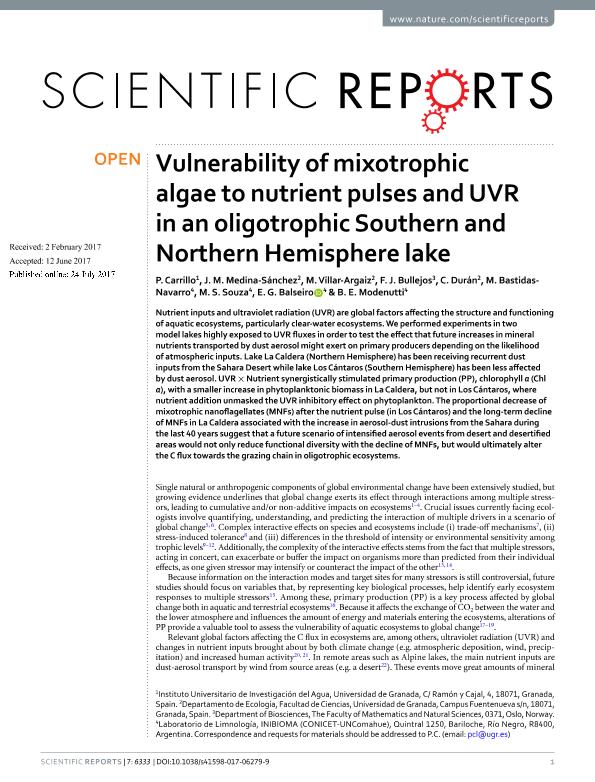Artículo
Vulnerability of mixotrophic algae to nutrient pulses and UVR in an oligotrophic Southern and Northern Hemisphere lake
Carrillo, P.; Medina Sánchez, J. M.; Villar Argaiz, M.; Bullejos, F. J.; Durán, C.; Bastidas Navarro, Marcela Alejandra ; Souza, María Sol
; Souza, María Sol ; Balseiro, Esteban Gabriel
; Balseiro, Esteban Gabriel ; Modenutti, Beatriz Estela
; Modenutti, Beatriz Estela
 ; Souza, María Sol
; Souza, María Sol ; Balseiro, Esteban Gabriel
; Balseiro, Esteban Gabriel ; Modenutti, Beatriz Estela
; Modenutti, Beatriz Estela
Fecha de publicación:
12/2017
Editorial:
Nature Publishing Group
Revista:
Scientific Reports
e-ISSN:
2045-2322
Idioma:
Inglés
Tipo de recurso:
Artículo publicado
Clasificación temática:
Resumen
Nutrient inputs and ultraviolet radiation (UVR) are global factors affecting the structure and functioning of aquatic ecosystems, particularly clear-water ecosystems. We performed experiments in two model lakes highly exposed to UVR fluxes in order to test the effect that future increases in mineral nutrients transported by dust aerosol might exert on primary producers depending on the likelihood of atmospheric inputs. Lake La Caldera (Northern Hemisphere) has been receiving recurrent dust inputs from the Sahara Desert while lake Los Cántaros (Southern Hemisphere) has been less affected by dust aerosol. UVR × Nutrient synergistically stimulated primary production (PP), chlorophyll a (Chl a), with a smaller increase in phytoplanktonic biomass in La Caldera, but not in Los Cántaros, where nutrient addition unmasked the UVR inhibitory effect on phytoplankton. The proportional decrease of mixotrophic nanoflagellates (MNFs) after the nutrient pulse (in Los Cántaros) and the long-term decline of MNFs in La Caldera associated with the increase in aerosol-dust intrusions from the Sahara during the last 40 years suggest that a future scenario of intensified aerosol events from desert and desertified areas would not only reduce functional diversity with the decline of MNFs, but would ultimately alter the C flux towards the grazing chain in oligotrophic ecosystems.
Palabras clave:
Uvr
,
Plankton
,
Southern And Northern Hemisferes
Archivos asociados
Licencia
Identificadores
Colecciones
Articulos(INIBIOMA)
Articulos de INST. DE INVEST.EN BIODIVERSIDAD Y MEDIOAMBIENTE
Articulos de INST. DE INVEST.EN BIODIVERSIDAD Y MEDIOAMBIENTE
Citación
Carrillo, P.; Medina Sánchez, J. M.; Villar Argaiz, M.; Bullejos, F. J.; Durán, C.; et al.; Vulnerability of mixotrophic algae to nutrient pulses and UVR in an oligotrophic Southern and Northern Hemisphere lake; Nature Publishing Group; Scientific Reports; 7; 1; 12-2017; 1-11
Compartir
Altmétricas



